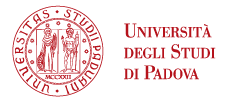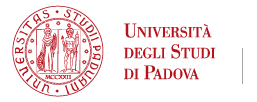
Zebrafish Facility
Location: Vallisneri's building, Viale G. Colombo n. 3 / via Ugo Bassi n. 58/B, I-35131, Padova, Italy
Opening hours: From Monday to Friday 8:00 a.m. to 7:00 p.m.
Contacts:
• E-mail: zebrafish.biologia@unipd.it
• Telephones: +39 049 827 6348 — +39 049 827 6203
Facility Director: Prof. Francesco Argenton; E-mail: francesco.argenton@unipd.it
Deputy Director: Prof. Natascia Tiso; E-mail: natascia.tiso@unipd.it
Facility manager: Dr. Martina Milanetto; E-mail: martina.milanetto@unipd.it
Overview
The Zebrafish Facility is located inside the inter-departmental building "A. Vallisneri" in Padova.
The Centre includes two wide rooms for fish housing, containing thirty aquarium cabinets for a total of about 1500 fish tanks. Each room is provided with an anteroom and an injection room.
Every aquarium cabinet lodges zebrafish larvae, juveniles and adults in 1-, 3.5- and 8-liter tanks. The system is provided with an osmotic pump delivering highly purified water with controlled salinity. Osmometers, pH-meters and thermometers allow conductivity, pH and temperature (28 C) control daily. Different cabinets are used to grow and maintain wild type, mutant or transgenic lines. One cabinet is specifically equipped for pair-wise or population crosses. Embryos and larvae are reared in dedicated cabinets with automatic feeding operated by a robotic system.
All embryos and adult fish are managed according to standard procedures listed in the Zebrafish Book (M. Westerfield ed.). Embryos are reared into small tanks (1 liter) without recirculation for 5 days and, starting from 6 days post-fertilization, fed four times a day with micronized dry food with water re-circulation. At day 15 larvae can be transferred to medium tanks (3.5 liters) with water re-circulation and thereafter fed four times a day with dry food and artemia. All tanks are cleaned at least every month, or when required, from wastes accumulated during rearing. When the fish reach the appropriate size, they can be transferred to 8-litre tanks and maintained during adulthood. Adult fish can spawn in pairs or groups inside mating tanks with a net on the bottom. Collected eggs are observed under dissecting microscopes and sorted according to their stage or phenotype. Embryos to be analyzed beyond 24 h post-fertilization are raised in 2 mM 1-phenyl-2-thiourea (PTU) medium to prevent their pigmentation, if optical clarity is required.





